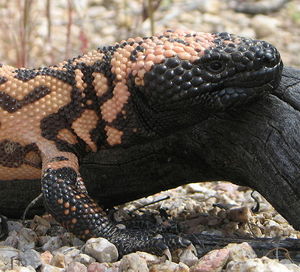Difference between revisions of "Gila Monster"
| (11 intermediate revisions by 3 users not shown) | |||
| Line 1: | Line 1: | ||
| − | {{ | + | {{unfinished}} |
| − | [[Image:Gila_Monster_head.jpg|300px|thumb|right|Gila Monster | + | [[Image:Gila_Monster_head.jpg|300px|thumb|right|'''Gila Monster''' (Wikimedia Commons)]] |
| − | + | ||
Scientific name: ''Heloderma suspectum'' | Scientific name: ''Heloderma suspectum'' | ||
| Line 8: | Line 8: | ||
The Gila monster is one of only two species of venomous lizard. They have large powerful jaws. The lower jaw has grooved teeth and associated venom glands. | The Gila monster is one of only two species of venomous lizard. They have large powerful jaws. The lower jaw has grooved teeth and associated venom glands. | ||
| − | The adults are large in size and may reach up to 60 cm in total length. The scales are bead-like on the back, sides, head and tail. Each one is rounded and set in relief. The colours are a black background with variable markings of orange/pink. No two lizards have exactly the same markings and this fact is used for identification of individual lizards. The head is blunt and swollen and the tail short and used for a fat store. A lost tail will not regenerate. They have short, well-developed limbs and claws used for burrowing. The forked tongue is constantly flicked out picking up scents, which are conveyed to the | + | The adults are large in size and may reach up to 60 cm in total length. The scales are bead-like on the back, sides, head and tail. Each one is rounded and set in relief. The colours are a black background with variable markings of orange/pink. No two lizards have exactly the same markings and this fact is used for identification of individual lizards. The head is blunt and swollen and the tail short and used for a fat store. A lost tail will not regenerate. They have short, well-developed limbs and claws used for burrowing. The forked tongue is constantly flicked out picking up scents, which are conveyed to the Jacobson's organ in the roof of the mouth. They are primarily nocturnal. |
==Range== | ==Range== | ||
| Line 19: | Line 19: | ||
==Enclosure== | ==Enclosure== | ||
| − | |||
In the wild these lizards are primarily nocturnal, remaining in burrows during the day to emerge at dusk and for part of the night. Vivariums with a large floor space of at least 150 x 90 x 60 cm are necessary. Gila monsters do best in plain cages with a sand substrate. Provide suitable rocks and retreats for the lizards. A thermostatically controlled ceramic heat source or alternatively a spotlight can provide heating with the appropriate wattage. Captive Gila will enter a low dish of water and soak there for long periods. | In the wild these lizards are primarily nocturnal, remaining in burrows during the day to emerge at dusk and for part of the night. Vivariums with a large floor space of at least 150 x 90 x 60 cm are necessary. Gila monsters do best in plain cages with a sand substrate. Provide suitable rocks and retreats for the lizards. A thermostatically controlled ceramic heat source or alternatively a spotlight can provide heating with the appropriate wattage. Captive Gila will enter a low dish of water and soak there for long periods. | ||
| Line 26: | Line 25: | ||
Daytime temperatures of 29-35ºC. Night-time temperatures should not fall below 23ºC. | Daytime temperatures of 29-35ºC. Night-time temperatures should not fall below 23ºC. | ||
| − | |||
| − | |||
| − | |||
| − | |||
| − | |||
| − | |||
| − | |||
| − | |||
| − | |||
| − | |||
| − | |||
| − | |||
Revision as of 12:45, 12 March 2010
| This article is still under construction. |
Scientific name: Heloderma suspectum
Description
The Gila monster is one of only two species of venomous lizard. They have large powerful jaws. The lower jaw has grooved teeth and associated venom glands.
The adults are large in size and may reach up to 60 cm in total length. The scales are bead-like on the back, sides, head and tail. Each one is rounded and set in relief. The colours are a black background with variable markings of orange/pink. No two lizards have exactly the same markings and this fact is used for identification of individual lizards. The head is blunt and swollen and the tail short and used for a fat store. A lost tail will not regenerate. They have short, well-developed limbs and claws used for burrowing. The forked tongue is constantly flicked out picking up scents, which are conveyed to the Jacobson's organ in the roof of the mouth. They are primarily nocturnal.
Range
Arizona, USA; Northern Mexico.
Diet
In the wild, Gila monsters feed on a variety of small mammals and the eggs of birds and reptiles. In captivity they need a diet rich in protein and calcium. The diet should include freshly killed rodents, eggs, chopped meat and bone meal. Supplementation is recommended.
Enclosure
In the wild these lizards are primarily nocturnal, remaining in burrows during the day to emerge at dusk and for part of the night. Vivariums with a large floor space of at least 150 x 90 x 60 cm are necessary. Gila monsters do best in plain cages with a sand substrate. Provide suitable rocks and retreats for the lizards. A thermostatically controlled ceramic heat source or alternatively a spotlight can provide heating with the appropriate wattage. Captive Gila will enter a low dish of water and soak there for long periods.
Temperature
Daytime temperatures of 29-35ºC. Night-time temperatures should not fall below 23ºC.
